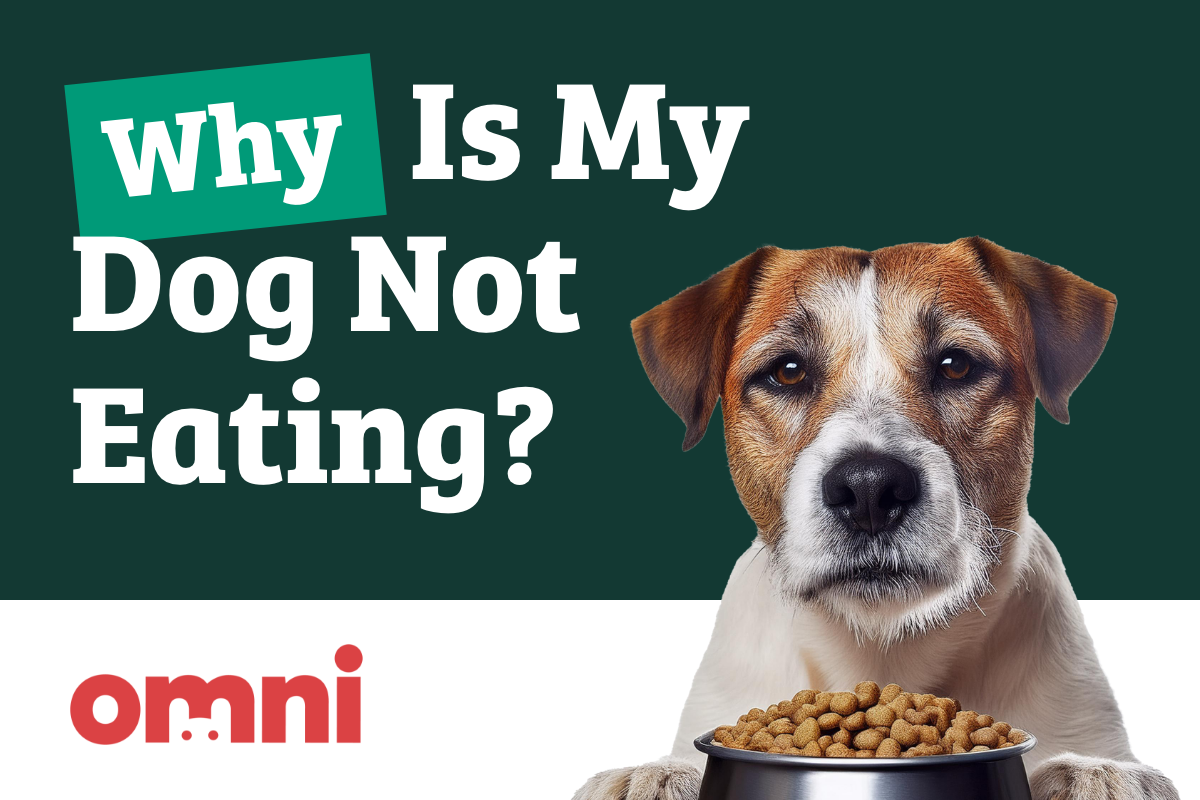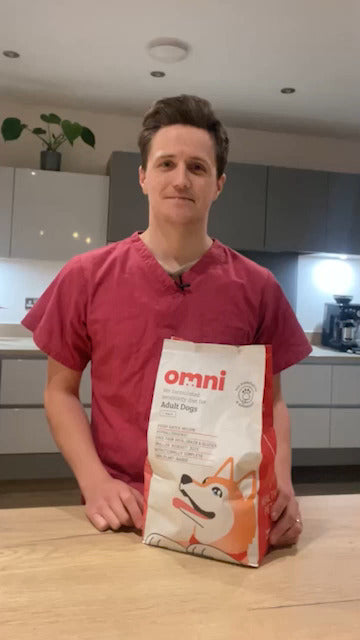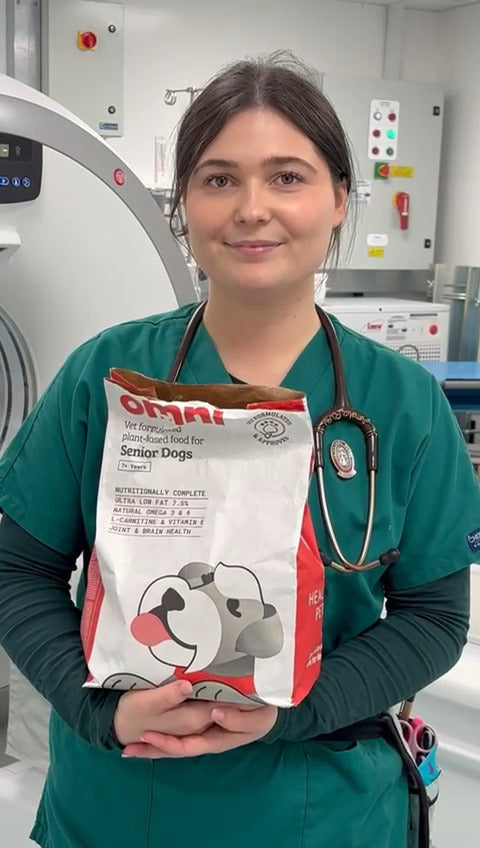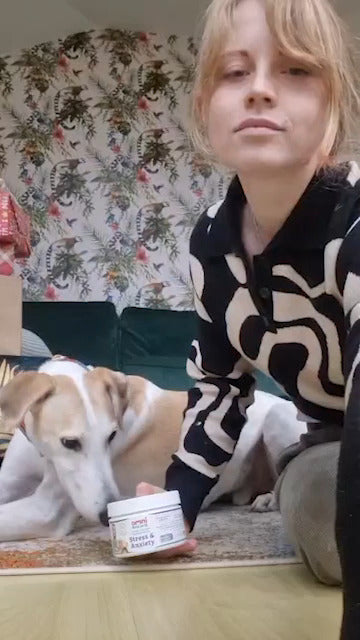Why Is My Dog Not Eating? (Help Needed!)

Why Is My Dog Not Eating?
Izzy is an older dog who lives with one of our Omni subscribers in the North of England. Unfortunately, Izzy isn’t yet on Omni’s food, though her adoptive brother, Chester, is.
As a nearly-thirteen-year-old Black Labrador, Izzy is starting to develop a few more lumps and bumps than she used to - and she’s also starting to display some more out-of-the-ordinary behaviours around food, too.
Last week, Izzy stopped eating the food she’s been fed on for many years - seemingly out of nowhere. It struck her guardians as odd, and they got in touch with us to ask the question that forms the backbone of this week’s article.
Why do dogs sometimes just stop eating food?
If you’ve got a problem you’d like to be included in Omni’s Ask a Vet series online, just drop us an email to woof@omni.pet.
Our Chief Veterinarian, Dr Guy MRCVS had this to say:
As any vet will tell you, there are a great many reasons for dogs to stop eating food. Among these are:
- Gastrointestinal upset and nausea from eating something they shouldn’t have.
- Pancreatitis - a painful condition where the dog’s pancreas flares up, potentially being caused by eating something very fatty.
- Fussiness. Even if your dog has never been fussy before, dogs have a propensity to change their tastes and become fussier as they get older.
- Stress. Even if your dog’s life seems stress-free, it probably isn’t!
- Something more sinister, like cancers or organ dysfunctions.
Why Is My Dog Not Eating?
Is Your Dog Feeling Nauseous?
Gastrointestinal upset often comes from dietary indiscretion - that is, eating or drinking something they shouldn’t have.
Think back: has your dog been on a walk around some questionable-looking piles of something unpleasant? Have they recently drunk from an oddly-coloured puddle or pond? Have they had new treats, eaten too much human food, drunk seawater, or even stolen items of clothing or toys they may have accidentally (or on purpose) swallowed?
You should check for:
- Lethargy and lack of energy.
- Vomiting, excessive lip licking, and over-salivating (all common signs of nausea).
- Diarrhoea, soft stools, or blood in stools.
- Pain around the abdomen
How to Help Your Dog Through Sickness
If your dog matches some or all of the symptoms above, in addition to reaching out to your in person vet our vet team recommend:
- Resting your dog. Only go out on short, controlled lead walks for 5-10 minutes around the block so that they have ample time to rest. Monitor their toilets (even when they go out at 3am!) so you know if and when they are passing diarrhoea, blood, straining, or even passing inedible and indigestible objects like fabrics.
- In the 3-7 days afterwards, make sure to feed your dog a bland, hypoallergenic diet and allow them access to plenty of clean drinking water. This will help them to flush toxins out of their system.
Does Your Dog Have Pancreatitis?
Pancreatitis in dogs is more common in some breeds than others, but it is generally caused by a high-fat foods which many dogs are unable to digest properly. This fat ends up inflaming the pancreas, causing it to swell and become painful.
If you suspect your dog’s inappetance (the veterinary term for not eating) might be due to pancreatitis, watch for these common symptoms:
- Vomiting, diarrhoea, and signs of abdominal pain.
- Lethargy and lack of energy or desire to get up and go for walks.
- Raised temperature caused by the inflammation of their pancreas.
- Dehydration.
- Tender abdomen
This could be caused by something fatty they have eaten (e.g., lamb) or by a genetic predisposition in certain breeds like Schnauzers.
How to Address Pancreatitis
If you suspect your dog's itching is due to pancreatitis, you will want to consider the following:
- Try and offer them some of their normal food, little and often, to ensure they are still eating. Preferably this should be a low-fat food in order not to exacerbate the problem.
- Rest them. Take them only on short lead walks, even if they are gradually feeling better.
- Take them to the vets if you notice they are not eating or drinking enough, or if they are unable to keep down what they are eating. The vets can provide pain relief, give sickness drugs, and run further tests.
Your Dog May Not Be Eating Because They Are Fussy
Even if your dog has never been too fussy before, fussiness can be developed for any number of reasons later in life, including a simple change of taste buds.
- Watch out for any vomiting and diarrhoea. Stomach bugs and generally upset tummies can easily be disguised as fussiness - so be wary!
- Progressive weight loss. Drop by your vet 1-2 weeks after onset of fussiness just to weigh your dog. Subtle weight loss can be difficult to measure when you see your dog on a day-to-day basis, but it can be indicative of a broader problem with their health and wellbeing.
- Lethargy and restlessness. Again, check this just to ensure that there isn’t a more concerning medical reason for your dog being put off their food.
- Not feeding a ‘fixed formula’ food. Some pet food brands have composite ingredients which means they can swap the ingredients according to what's available at the time of manufacturing (and often what's cheapest!). You may see this as ‘animal derivatives’ on the ingredient list as an example, if that particular ingredient isn’t something your dog enjoys it could suddenly put them off a food they enjoyed before. All of Omni’s products are fixed formulas, which means the same ingredients are used every time!
How to Feed a Fussy Eater
- Try mixing in something tasty to their ordinary food to encourage them to eat more. At Omni, we’ve developed the perfect hypoallergenic taste toppers for situations like this, for example.
- Try and stick to defined mealtimes so that they know to eat when their food is put down. Avoid offering them human foods as treats, or else they may learn to hold out in favour of something ‘better’.
- Move onto a taste optimised recipe designed for fussy eaters like Omni Sensitivity. Omni Sensitivity is formulated by vets to be tastier, easier to eat, and free of all major causes of sensitivity, allergies, or fussiness. It has apple and other delicious natural ingredients dog love to eat and is suitable for adult and older dogs of all breeds and size.
Is Your Dog Stressed and Not Eating?
Your dog’s life probably seems easy and stress-free compared to yours. But put yourself in their shoes for a second…
Imagine that everyone around you spoke a language you didn’t understand. You often get taken in the car but you have no way of knowing where you’re going. Your walks are around other dogs whose intentions are a mystery - sometimes they get too close and try and bite you for no apparent reason! You don’t really control when you get to eat, or what you eat, for that matter. You have to bark at the door to be let out to the toilet. And you can’t tell the vet what’s wrong with you when you are unlucky enough to be taken to get poked and prodded for reasons you don’t quite understand!
Put like that, life for your dog is a bit more stressful than you might think. Many dogs also come from stressful backgrounds, so it’s even more advisable to keep a mind to your dog’s potential anxiety by watching out for:
- Cowering and fearful body language, especially towards certain people (like men or people holding items that might be used to hit them with).
- Shaking during and after situations that may frighten them.
How to Help a Dog Through Stress and Anxiety
Once you’ve made a note of any particular triggers, like aggressive or hyperactive dogs, post deliveries, dog groomers, et cetera., try and help your dog through these moments by perhaps consulting your vet or a recommended dog behaviourist to help set your dog up for success in future.
Does Your Dog Have Chronic Pain, Cancer or Organ Dysfunction?
Firstly, don’t overthink this one. These conditions are statistically rare (although commoner than we’d like them to be!) and your dog not eating is by no means a sign that cancer or organ dysfunction is a likely explanation.
That said, keep an eye out for symptoms like:
- Tenderness anywhere on the body
- Unexpected and progressive weight loss and loss of muscle condition. Your dog ‘wasting away’ like this can be due to conditions like cancer. In this case, seek medical advice and intervention.
- Lethargy and restlessness.
- Disinterestedness in food.
- Irregular toileting, such as not urinating or urinating too much, diarrhoea or constipation, needing to go to the toilet at irregular times, et cetera.
- Vomiting.
- Jaundice (a yellow appearance of the eyes and skin).
- Pot belly appearance, caused by swelling and inflammation of the abdomen and a build up of fluids.
What to Do About Canine Cancer or Organ Failure
If your dog is older and suddenly seems not quite themselves, it is always worthwhile having them examined by an expert by taking them to your local vets - which is exactly what we advised with Izzy.
Typically, older dogs like Izzy - just like older people - are less able to deal well with illness, and are at higher risk of developing more serious conditions as their bodies age through wear and tear. As a result, the sooner you can provide them with treatment, the better the outcome is likely to be.
Book in with your vet for a general checkup to discuss what treatments and tests are best placed to benefit your dog.
Speak with a vet if…
There are other clinical signs seen, or it is still unclear what may be causing your dog’s inappetance.
Take your dog to your vets if…
Your dog hasn’t eaten anything or kept anything down for more than 24 hours.
Thoughts from Dr Guy MRCVS
As dog lovers and guardians, it’s natural to worry about our furry friends, especially when they display abnormal symptoms that can’t be easily explained. That’s why, when I founded Omni, I knew that I wanted to keep vet consultation free and accessible at the heart of the business.
If you’re understandably worried about your dog, but you don’t think you need to take them to the vets urgently, I highly recommend getting some friendly, professional advice from one of our team.
Got a question for the Ask a Vet team?
Submit your question below, or email it in to woof@omni.pet. We’ll get back to you as soon as we can, and, if suitable, post the response here to help others, too!
Disclaimer: Whilst the advice given here is based on medical experience from our experts, and scenarios we do encounter during our career - we do not give tailored or specific advice for individual pets - please seek assistance from your in person vet as a first point of call with any issues your pet is having which are a cause for concern as soon as possible.







 85 Great Portland Street, 1st Floor, London, W1W 7LT United Kingdom
85 Great Portland Street, 1st Floor, London, W1W 7LT United Kingdom